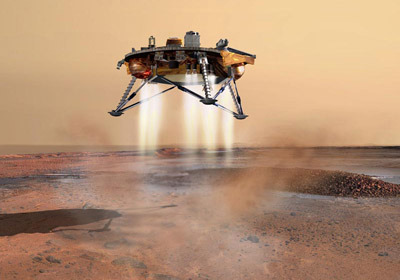The Mars probe and the fear of failure
In a few days a probe will prepare to land on Mars. The Phoenix probe will dig up the planet's land to search for snow and traces of life - if it passes a dangerous landing.
In fact, the planet explorer was "dead" once 8 years ago, when the US Space Agency (NASA) canceled the flight named Mars Surveyor 2001 Lander in the spring of 2000.
The origin of this cancellation is that two other expeditions failed completely a few months ago: The Mars Climate Orbiter was launched into a low and crumbling Mars orbit in the atmosphere. Mars Polar Lander is probably due to technical problems that have not been braked to the ground of Mars and silenced forever.
In such a situation, NASA authorities must rule out the possibility of continuing failure at all costs. The third flight was thus canceled and the Phoenix ship nearing completion was put into storage.
After three years of thinking, space managers changed their minds and decided to refurbish the ship. Phoenix's 2007 revival: The last explorer ship was launched to Mars, part of the Mars Scout program - a test of planetary exploration with smaller probes - and especially cheaper.

Illustrating the Phoenix ship landed on Mars.(Photo: NASA)
Since its departure in August last year, Phoenix has surpassed nearly 700 million kilometers. The ship will land near the north pole of Mars on Sunday. This is a difficult task: It must be braked with parachutes and missiles, reducing the speed from 20,000 km / hour to less than 10 km / hour to be able to gently land on Mars's ground afterwards.
This exercise is so difficult that NASA is worried about a collision without braking. To make an explorer ship safely down to Mars is a complicated and risky job. Out of a dozen dozen rounds of Martian encounters over the years, less than half were successful, only five expedition ships landed safely.
NASA surveyed the answer point for Phoenix and hoped that the place would be flat and free from rocks. The ship must respond in a predetermined position because it is not capable of moving like two Spirit and Opportunity robots. Thanks to an aluminum and titanium arm, Phoenix will sample Martian soil. And thanks to the ability to dig 50 cm deep, the researchers hope Phoenix will find frozen water right below the ground.
But the decisive question so far is still: Is there ever a life on Mars? "There is very little possibility of life in Mars's equatorial equator, if there are only two poles," said planetary researcher Gerhard Neukum. But Phoenix has no equipment to be able to prove life directly - for example, in the form of bacteria. At most, it is only possible to prove indirectly through analysis of soil samples. The explorer ship has a small furnace on the top to heat the soil samples and analyze their chemical composition.
NASA researchers believe that this Mars lab will work for 3 months. But these times should not be carved into stone. Two Spirit and Opportunity robots have shown that even if the expected long-running time period can provide a lot of remarkable results. In order to be able to write a successful history of explorers Mars, the first Phoenix is to be able to get past the Martian landing without being damaged. It was once revived and that was enough.
- NASA revealed the mission of the next Mars probe
- The Mars probe is ready to land
- India's Mars probe boarded a 100,000 km orbit
- India moved on the launch of the Mars probe
- India launched a Mars probe
- India will bring the probe to Mars in 2013
- Learn how to experience failure to succeed
- Curiosity is about to drill a third nose on Mars
- This process of painting the Mars probe is so complex and meticulous
- The third nose is Mars on Mars
- Mars once existed drinkable water
- The space probe shows that Mars is cooler inside.
 Van Allen's belt and evidence that the Apollo 11 mission to the Moon was myth
Van Allen's belt and evidence that the Apollo 11 mission to the Moon was myth The levels of civilization in the universe (Kardashev scale)
The levels of civilization in the universe (Kardashev scale) Today Mars, the sun and the Earth are aligned
Today Mars, the sun and the Earth are aligned The Amazon owner announced a secret plan to build a space base for thousands of people
The Amazon owner announced a secret plan to build a space base for thousands of people